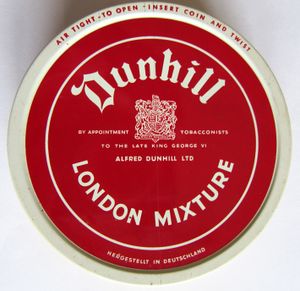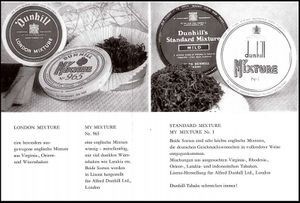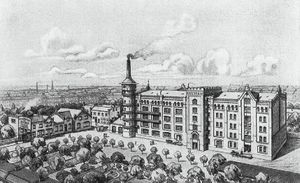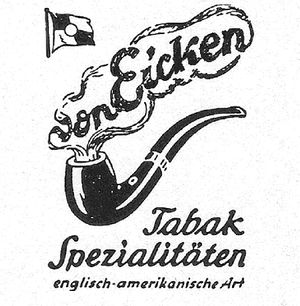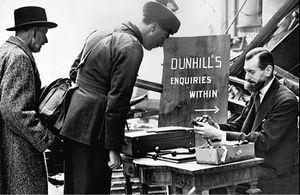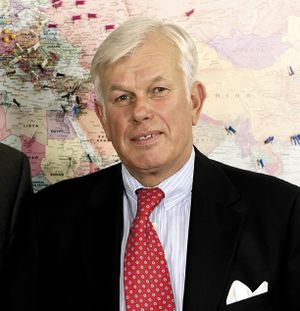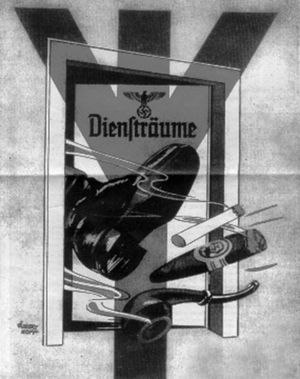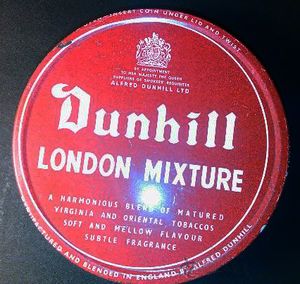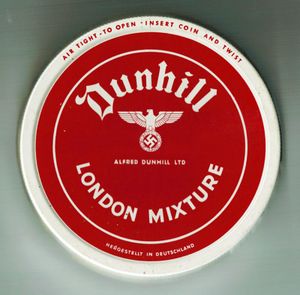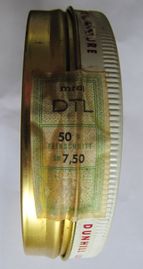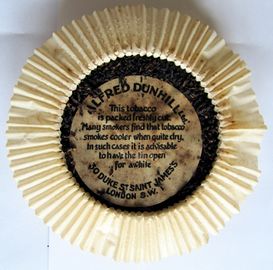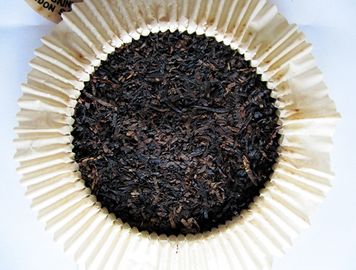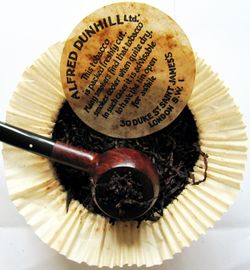Un ancien tabac Dunhill "made in… Germany!?"
Article publié à l'origine sur le blog A Dutch Pipe Smoker (Fumeur de Pipe Hollandais), et utilisé avec la permission de l'auteur. Cette version est inédite.
Mis à disposition par Yang Forcióri et traduit par Jean-Christophe Bienfait
Il y a quelque temps, je chinais sur le ebay allemand, à la recherche d'une chose ou l'autre. Je suis tombé sur deux boîtes de tabac Dunhill anciennes, un Standard Mixture Medium et un London Mixture. Malheureusement, la description indiquait que les deux boîtes étaient ouvertes, mais pleines. Je me suis dit que je pourrais probablement réhydrater les tabacs et comme le prix était correct, j'ai décidé de prendre le risque et d'acheter les deux boîtes. Quand j'ai reçu et ouvert le paquet, j'ai vu à ma grande joie que la boîte de London Mixture était encore scellée. Oui, oui ! Sans trop réfléchir, j'ai rangé mes deux acquisitions dans ma cave à tabac.
Quelques mois plus tard, je fouillais dans ma réserve de tabacs anciens, à la recherche de je ne sais plus quoi, lorsque j'ai revu la vieille boîte de London Mixture. Je l'ai regardé de plus près et mon regard est soudain tombé sur une phrase au revers de la boîte : Hergestellt In Deutschland. Quoi !? Fabriqué en Allemagne !!?? J'ai toujours cru que les anciens tabacs Dunhill étaient fabriqués au Royaume-Uni, d'abord par Dunhill lui-même, puis en 1981 par Murray (et de 2005 à aujourd'hui par Orlik au Danemark). Comme vous pouvez l'imaginer, ma curiosité a été éveillée. J'ai donc commencé à me renseigner sur les forums internationaux sur la pipe. Sur le forum PipesMagazine.com, je ne suis pas allé très loin, malgré des réactions amicales. C'est un peu logique, car ce forum est davantage orienté vers l'Amérique.
C'est alors qu'un autre fumeur de pipe néerlandais, Huub, est venu à la rescousse : "Arno, je suis membre d'un forum allemand, Freunde Der Tabakpfeife (Les amis de la pipe). Je vais essayer d'y recueillir quelques informations". Et voilà qu'en un rien de temps, Huub a pu me dire que plusieurs personnes avaient réagi à ma question sur les origines de la boîte London Mixture. Je suis également devenu membre du forum et j'ai consulté le fil de discussion que Huub avait ouvert pour moi.
J'y ai trouvé beaucoup d'informations et plusieurs pistes. Il s'est avéré que ma boîte a été fabriquée sous licence de Dunhill par Joh. Wilh. von Eicken GmbH, qui fabriquait également d'autres produits Dunhill à l'époque. J'avais du mal à y croire et, comme preuve, j'ai téléchargé sur le forum FDT une ancienne publicité pour les tabacs Dunhill fabriqués en Allemagne. J'en ai appris davantage sur Von Eicken dans un livre sur les anciennes entreprises de Hambourg.
Dès 1770, Johann Wilhelm von Eicken a commencé à commercer avec les colonies et a fabriqué son tabac à pipe et à priser à Mülheim. En 1866, Carl Heinrich von Eicken prit la direction de l'entreprise. Il arrêta le commerce avec les colonies et poursuivit la production de tabacs. En 1886, il acheta une autre usine de tabac à Hambourg. L'usine de Hambourg ne sera pas épargnée par la Seconde Guerre mondiale, elle sera partiellement détruite lors de raids aériens en 1943. L'usine de Mülheim sera complètement détruite lors des raids aériens de l'US Air Force. Peu avant la fin de la guerre, en 1944, la fermeture de l'usine de Hambourg fut ordonnée par les nazis. Le bâtiment était nécessaire pour la production d'appareils à rayons X... Hans von Eicken, âgé et malade, transmit l'entreprise à son fils Wilhelm quelques mois seulement avant la fin de la guerre.
L'autorisation officielle de reprendre la fabrication du tabac fut accordée en 1949. Le tabac Virginia américain, indispensable à la production, était disponible à la fin de l'automne de la même année grâce au plan Marshall (93 000 tonnes de tabac ont été expédiées gratuitement en Allemagne !). En 1963, Von Eicken obtint les droits exclusifs d'importation et de distribution du tabac Mac Baren en Allemagne, qu'il distribua avec succès jusqu'en 2008. En 1983, la décision fut prise de transférer l'usine à Lübeck. Marc von Eicken est la huitième génération à rejoindre l'entreprise en 1997. Depuis, il dirige Von Eicken avec son père Johann Wilhelm.
La chose la plus intéressante que j'ai lue dans le livre (et vue sur le forum FDT) est de loin que Von Eicken avait déjà pris contact avec Dunhill en 1926, et la permission de produire des tabacs sous licence fut accordée en 1938. 1938... Avec un choc, j'ai réalisé qu'Adolf Hitler régnait sur l'Allemagne nazie cette année-là. Donc, l'une des entreprises britanniques par excellence a accordé une licence de tabac à une entreprise de l'Allemagne nazie ??? Oui, mais ce n'est pas aussi noir et blanc que vous le lisez ici. En 1938, la plupart des pays occidentaux avaient adopté une vision optimiste de ce que Winston Churchill a appelé plus tard "l'orage qui s'amorce en Europe". Une politique d'apaisement à l'égard d'Adolf Hitler avait été lancée en Grande-Bretagne par Lord Halifax et le président américain Roosevelt avait signé les lois de neutralité américaines. Le Premier ministre britannique, Neville Chamberlain, rencontra Hitler dans son appartement de Munich. Plus tard dans la journée, il prit l'avion pour rentrer chez lui et brandit la déclaration commune d'intention pacifique, qu'ils avaient tous deux signée. Il fit également remarquer que "tout ceci sera terminé dans 3 mois" et "je crois que c'est la paix pour notre époque".
Pour Dunhill, 1938 fut une année de consolidation. L'entreprise reçut un mandat royal du roi George VI fraîchement couronné et des agences furent créées dans le monde entier. Le principal agent de Dunhill à Londres, la société Abel & Imray, tenta, par l'intermédiaire d'un avocat local, d'enregistrer les noms "Dunhill", "Rich Dark Virginia", "Standard Mixture" et "My Mixture"en Allemagne. Malheureusement, la société fut informée par les autorités allemandes qu'elle ne pouvait pas utiliser le représentant qu'elle avait choisi parce qu'il avait été "exclu de la profession" parce qu'il était juif.
On peut parier que Von Eicken faisait mieux l'affaire. Hélas, en fin de compte, Hitler réussit à obtenir plus de temps (ainsi il put achever son armement). Le 3 septembre 1939, la Grande-Bretagne et la France déclarèrent la guerre à l'Allemagne et en 1941, le magasin Dunhill fut bombardé...
Despite the knowledge at the FDT forum and things I read I still had some questions. So I boldly decided to mail Von Eicken themselves in the hope to verify and gain some information. And lo and behold, a couple of days later I got a mail back from the older director, Herr Johan Wilhelm Von Eicken. His answers were very short, sometimes I did not know what he precisely meant but anyway, I was thankful. Below are the questions I had and the answers to the best of my abilities.
Why did Dunhill give a license to produce their tobaccos to Von Eicken? The answer is pretty simple: economical reasons. In 1929 Dresden internist Fritz Lickint presented statistical evidence through a published case-series study which linked lung cancer and tobacco usage. So the Nazis began one of the first public anti-smoking campaigns in modern history. Hence the term “anti-smoking Nazis”.. A motivating factor was Adolf Hitler’s personal distaste for tobacco. Despite the fact that he was a heavy smoker in his early life. He used to smoke 25 to 40 cigarettes daily but gave up the habit, saying that it was “a waste of money”. Another motivation behind the Nazi campaign against smoking were their reproductive policies. The campaign included banning smoking in trams, buses and city trains, promoting health education, limiting cigarette rations in the Wehrmacht, organizing medical lectures for soldiers and raising the tobacco tax. So to get their tobaccos to the German consumer Dunhill first had to import their tobacco into Germany and pay import-duties. And on top of that the increased tobacco-tax made their offerings even more expensive. But with the tobacco made in Germany they avoided the import duties, enter Von Eicken. After the war the Deutsche Mark had little value as opposed to the British Pound thus everything coming from Great Britain was expensive. So once again The Von Eicken factory came in handy for Dunhill.
Did Von Eicken use the same recipes as the original London made ones?
Herr Von Eicken wrote that their Dunhill tobaccos were a close copy to the original. But according to some members the German Dunhill offerings were, uhm, not so good. FDT member Uli says: “As a student I started smoking in 1959. Soon my favourite tobacco became Dunhill Standard Mixture and it was (amongst other Dunhill offerings) made in Germany. One time in Switzerland I bought myself an original Dunhill tin, the difference was striking! After that I never bought a German made Dunhill tobacco.” German friend and walking pipe-smoking encyclopaedia Rainer confirmed this. He told me that an old pipe smoking friend of him said that the German made London Mixture was awful compared to the original.. Great, I thought, I apparently bought a tobacco tin that can rival with the dreaded Clan (by Theodorus Niemeijer)…
Did Von Eicken kept producing Dunhill tobacco in Nazi Germany until 1943, when their factories were bombed by the allied forces? According to Herr Von Eicken there was no leaf tobacco available in the war, so, no. Tobacco rationing was imposed in the beginning of the war and almost 70% of the available smoky leaf was diverted to the armed forces for the remainder of WWII. Also I can’t imagine that such a luxury product as Dunhill tobacco was bought by the struggling German population. But one has to admit, it is a tantalizing thought that perhaps some tins were made at the end of 1938 and beginning of 1939. That would really be a kind of sinister holy grail of Dunhill tobacco.
When did Von Eicken stop producing Dunhill tobacco in license? Once again I had to lean on Rainer because I did not understand the answer of Herr Von Eicken.. According to Rainer sometime before 1976 when he started to buy pipe tobacco the original Dunhill tobaccos became available in Germany and Von Eicken ceased their production. Perhaps Dunhill noticed that a lot of German pipe-smokers bought their tobaccos abroad.. Who knows.. One thing is sure, when Murray took over Dunhill production Von Eicken no longer made their version.
Back to the tin of German London Mixture I bought. You can see a George VI crest with a reference to the “late King”. So according to John Loring this tin was made between 1954 and 1962. Personally I believe it is closer to 1962 than to 1954 because of the price you see on the tax-seal, DM 7,50. This because Rainer says that halfway the 1970’s such a tin costed around DM 8,00. But still, in the “worst case scenario” my tin is 52 years old, yiehaaa!!!
Of course I had to open the tin. Rainer constantly kept semi-seriously nagging me to “write the blog and afterwards sell the sealed tin for a huge sum” but that is not me. So on one of the last summer days I cracked the still intact vacuum seal. On top of the tobacco was a paper insert placed with the text “This tobacco is packed freshly cut. Many smokers find that tobacco smokes cooler when quite dry. In such cases it is advisable to have the tin open for a while.”
With the paper insert removed the tobacco looked just fine in my eyes. No mould or anything like that, just mostly dark coloured ribbon cut strands with some lighter ones. Despite that the vacuum seal had been intact the contents were a little bit on the dry side but still perfectly smokeable. The smell of the tobacco inside was a bit strange. I noticed that the strength of the latakia had diminished and what was left is best described as a McClelland latakia tobacco with instead of the ketchup odour a bit of a sweet liquorice smell with a rotten edge. The original Dunhill tobaccos were (in)famous for their “rotten” smell so probably Von Eicken tried to mimic this.
I filled a 1962 Root Briar Dunhill prince with the German London Mixture and set fire to the old tobacco. I was aware that people said that the German version was awful compared to the original but all by all I had a decent smoke. Nothing spectacular but just.. Decent.. I had no old original London Mixture tin so comparing it was difficult. Only thing I had was a tin of the Murray version, so in the next days I also smoked that one. In the afternoon the Murray version, in the evening the Von Eicken one. Of course the Murray tobacco was fresher, the latakia more present and pungent. But when I adjusted the taste in my mind I found some similarities. The original description for London Mixture read: “A delightfully harmonious blend of matured Virginia and Oriental tobaccos, soft and mellow, cool and fragrant.” Mr Pease said about the original: “It had a richness, a sophisticated elegance, and a complex nature that kept it from being tiring. It was full enough to satisfy, but never overbearing. It was comfort food for the pipe.” I could find myself in these descriptions. Both blends were very harmonious, one good taste throughout the bowl without a roller-coaster ride of different flavours, comfort food. The Murray version had a certain richness and was soft and mellow. On the other hand The Von Eicken blend bit me sometimes and lacked the complex nature.
All by all it was a fascinating experience smoking the German made London Mixture. Especially with the story behind it. I would like to thank Huub, Rainer, the folks at the FDT forum and Herr Von Eicken for their help and input.
Vintage Dunhill tobacco made in… Germany!?, by Arno, a Dutch pipe somoker[1]
